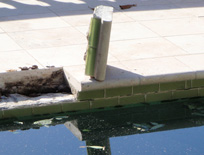Cold Joints: Avoiding Costly Repairs

 In pool-remodeling work, it’s very common to raise a bond beam to meet the needs of a new deck or edge detail — or simply to make the pool level again.
In pool-remodeling work, it’s very common to raise a bond beam to meet the needs of a new deck or edge detail — or simply to make the pool level again.
As ordinary a step as this may seem, it can be trickier than you might think because, in applying new, poured concrete atop the old gunite or shotcrete, you create what is known as a cold joint — that is, a space where you need to be certain you’ve created a good, reliable bond between the new material and the old.
Scenario: I inspected a project where a floated bond-beam addition had cracked at a point behind the tile line that was just below the water’s new level. This caused a leak that oversaturated a surrounding clay soil with moderately expansive properties. When that clay started to swell, it heaved the concrete all the way around the pool, damaged the skimmer and created a number of trip hazards.
To take care of the problem, a contractor had to come in, remove the concrete decking, pull up the coping and cut away all of the tile before basically redoing the original renovation contractor’s work. All told, it was a $60,000 repair.
The Fix: All of this hassle might have been avoided had the original renovation contractor followed a few simple steps.
First, after a preliminary cleaning, he or she should have roughed up the surface using hammers and chisels. This increases the contact surface between old and new material and offers the best possible chance of subsequently establishing a good mechanical bond.
Next, the contractor should have made the top surface of the original bond beam as clean as possible — meaning free of all dirt, dust and debris. We accomplish this in our own projects by pressure-washing the old material, which not only cleans things up but also thoroughly wets the concrete, thereby helping with the next step.
Now the contractor should have applied a thin film of cementitious paste over the surface of the existing material. For this purpose, we brush a high-performance, non-shrinking concrete onto the surface. (We know a number of contractors who also add some concrete glue to the mix to increase flexibility.) Note that this is not regular cement, which will shrink and pull itself away from the bond and cause the cold joint to fail.
Within minutes of brushing on the cementitious paste, we pour the new concrete — again using non-shrinking, high-performance concrete. Yes, it’s more expensive, but it will not shrink or fail the way regular concrete will in this sort of critical application.
In using this high-performance material (or any concrete material, for that matter), it is crucial to follow manufacturer instructions to the letter with respect to water-to-cement ratios and overall measurements. Put aside the Big Gulp cups and shovels: Always use marked measuring containers so you can be sure the mix is correct.
Once this concrete is placed, it’s important to consolidate the material by vibrating it, either mechanically or manually. That’s all there is to it.
Lesson Learned: Whenever you’re creating a cold joint, be sure to follow the basic steps needed to establish a reliable bond. Otherwise, the damage to the pool and adjoining structures can be severe — and costly!
Scott Cohen is president and supervising designer of The Green Scene, an outdoor design and construction firm based in Canoga Park, Calif. He provides consultation for clients nationwide and gives seminars on designing landscapes, swimming pools and outdoor kitchens. For more information, visit www.greenscenelandscape.com.









